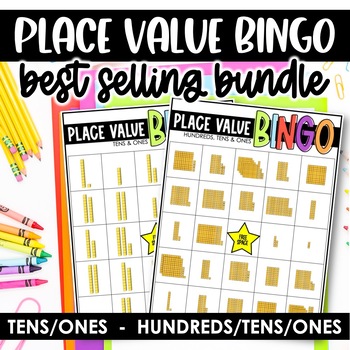Place Value Games for Place Value Centers and Place Value Practice
- Zip
What educators are saying
Also included in
- These five math bingo games make kids forget they are even learning math and cover basic fractions, telling time, place value/base ten, and basic number sense with ten frames. Because of the variety of skills covered in this bundle, it provides great differentiation! These bingo games can be playPrice $11.75Original Price $15.00Save $3.25
Description
Place value review has never been this much fun now that you have this place value game! Students will love working on their place value skills by playing bingo - they will be identifying base ten blocks on their place value bingo board!
WHAT IS INCLUDED IN THESE MATH GAMES?
⇨ Version One: 30 unique bingo cards where students will need to identify hundreds, tens and ones
⇨ Version Two: 30 unique bingo cards where students will need to identify tens and ones
⇨ 2 teacher calling cards (one for each version)
⇨ 2 templates for students to create their own bingo cards (one for each version)
WHAT WILL MY STUDENTS BE DOING?
⇨ Identifying hundreds, tens, and ones on a bingo card
⇨ Identifying tens and ones on a bingo card
⇨ When students get 5 in a row on their card, they have a BINGO!
⇨ *Teacher Tip* Have students identify the number in each box of their bingo card BEFORE playing! This will speed up your game play.
WHAT ARE OTHER TEACHERS SAYING ABOUT THESE MATH GAMES?
⭐️⭐️⭐️⭐️⭐️ 'I absolutely loved this! The kids were engaged, had fun, and learned at the same time. I definitely would recommend using this game!' -Leena
⭐️⭐️⭐️⭐️⭐️ 'Kids loved playing this game. I really liked how I could differentiate for the students that were ready to add the hundreds in!' -Maranda
⭐️⭐️⭐️⭐️⭐️ 'I love this product. It's such a good idea and saved me so much time instead of making it myself. My kids are going to love practicing place value understanding with this fun game!' -Jessica
⭐️⭐️⭐️⭐️⭐️ 'Such easy prep - I printed 2 per page, laminated, and cut and it was ready to go. My Grade 2s played this week and LOVED it. Great number review. Awesome as well that there are no words (just images and the word "Bingo") as I teach French Immersion. Thank you!' -Jennifer
▁▁▁▁▁▁▁▁▁▁▁▁▁▁▁▁▁▁▁▁▁▁▁▁▁▁▁▁▁▁▁▁▁▁▁▁▁▁
WHO IS THIS RESOURCE FOR?
• Classroom teachers or interventionists that want a fun, low-prep way to get their kids excited about reviewing place value.
• Classroom teachers looking for an activity to leave for a substitute teacher.
▁▁▁▁▁▁▁▁▁▁▁▁▁▁▁▁▁▁▁▁▁▁▁▁▁▁▁▁▁▁▁▁▁▁▁▁▁▁
Copyright © Cupcakes & Curriculum
Permission to copy for single classroom use only.
Please purchase additional licenses if you intend to share this product.
▁▁▁▁▁▁▁▁▁▁▁▁▁▁▁▁▁▁▁▁▁▁▁▁▁▁▁▁▁▁▁▁▁▁▁▁▁▁





